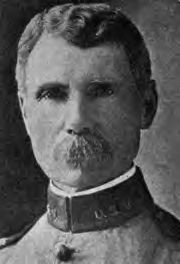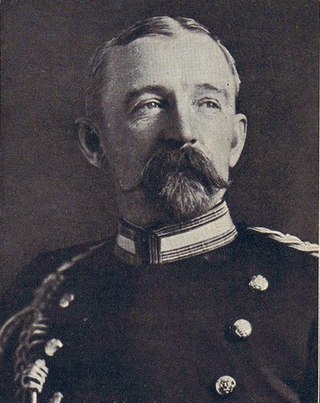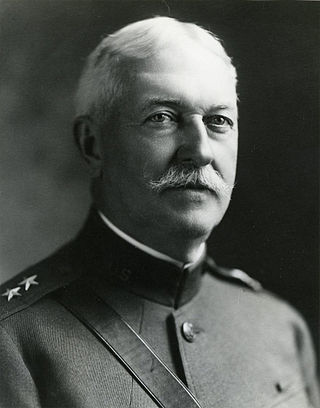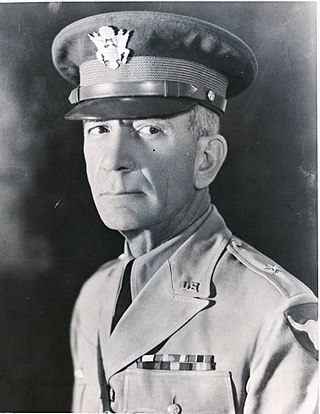
Theodore Schwan was a Union Army officer during the American Civil War who received the Medal of Honor for his actions at the Battle of Peebles' Farm. He also served with distinction during the Spanish–American and Philippine–American Wars.

Asa Peabody Blunt was an officer in the Union Army during the American Civil War. He remained on active duty after the war. In recognition of his service during the Civil War, he was appointed to the grade of brevet brigadier general of volunteers. Blunt was notable as commander of the 2nd Vermont Brigade and the United States Disciplinary Barracks at Fort Leavenworth, Kansas.

The Quartermaster General of the United States Army is a general officer who is responsible for the Quartermaster Corps, the Quartermaster branch of the U.S. Army. The Quartermaster General does not command Quartermaster units, but is primarily focused on training, doctrine and professional development of Quartermaster soldiers. The Quartermaster General also serves as the Commanding General, U.S. Army Quartermaster Center and School, Fort Lee, Virginia and the traditional Quartermaster Corps.

Charles Albert Woodruff was a career officer in the United States Army. A veteran of the American Civil War, American Indian Wars, Spanish–American War, and Philippine–American War, he attained the rank of brigadier general before retiring in 1903.

Samuel D. Sturgis Jr. was a senior officer of the United States Army who commanded the 87th and 80th divisions during World War I.

Grote Hutcheson (1862–1948) was an officer of the U.S Army from 1884 to 1924. After graduating from USMA in 1884, Hutcheson participated in the Pine Ridge Campaign. During the Spanish–American War, he was Adjutant General of the Puerto Rican Campaign. From 1899 to 1990, Hutcheson participated in the China Relief Expedition in which he received two Silver Star Commendations. From 1901 to 1902, Hutcheson was secretary to the Military Governor of the Philippines. He was then judge advocate of the Department of the East in Governor's Island, New York. From 1904 to 1908 Hutcheson was on the General Staff, serving in the office of Chief of Staff. From 1908 to 1910 and 1915 to 1916, Hutcheson was on the Mexican border. During World War I, Hutcheson formed the port of embarkation and Norfolk from 1917 to 1918, in which he was awarded the Army and Navy Distinguished Service Medals. Hutcheson then commanded the Fourteenth Infantry Division as major general. From 1920 to 1923, Hutcheson commanded the New York General Intermediate Depot as brigadier general and the Eleventh Field Artillery Brigade. Hutcheson retired in 1924 as major general due to disabilities.

William Payne Jackson was a career officer in the United States Army. A veteran of the American Indian Wars, Spanish–American War, Philippine–American War, Moro Rebellion, Pancho Villa Expedition, and World War I he attained the rank of brigadier general during his career and major general on the army's retired list.

Julius A. Penn was a career officer in the United States Army. He attained the rank of brigadier general during World War I, and commanded 170th Infantry Brigade, 85th Division and 76th Infantry Brigade, 38th Division, in addition to serving as Chief of the Personnel Bureau for the American Expeditionary Forces.

Samuel Beckley Holabird was a career officer in the United States Army. A Union Army veteran of the American Civil War, Holabird attained the rank of brigadier general and is most notable for his service as the Army's Quartermaster General, a position he held from 1883 to 1890.

Frederick S. Strong was a career officer in the United States Army. He attained the rank of major general, and was a veteran of the American Indian Wars, Spanish–American War, and World War I. Strong was best known for his command of the Hawaiian Department from 1916 to 1917 and the 40th Division during World War I.

David C. Shanks was a career officer in the United States Army. A graduate of the United States Military Academy, he attained the rank of major general, and was a veteran of the Spanish–American War, Philippine–American War, and World War I. He was most notable for his command of the Hoboken Port of Embarkation and 16th Division during the first World War, and was a recipient of the Army Distinguished Service Medal and Navy Distinguished Service Medal.

Marcus Peter Miller was a career officer in the United States Army. A Union Army veteran of the American Civil War and a U.S. Army veteran of the American Indian Wars, Spanish–American War, Philippine–American War, he served from 1858 to 1899, attained the rank of brigadier general, and was commended for gallantry during several Civil War battles, the Modoc War, Nez Perce War, and the Iloilo campaign of the Philippine–American War.

Casper H. Conrad Jr. was a career officer in the United States Army. A veteran of the Spanish–American War, Philippine–American War, Pancho Villa Expedition, and World War I, he served from 1895 to 1936 and attained the rank of brigadier general.

Ernest Hinds was a career officer in the United States Army. A veteran of the Spanish–American War, Philippine–American War, and World War I, he attained the rank of major general and was notable for his service as Chief of Artillery for the American Expeditionary Forces during the First World War and his post war command of the 2nd Division and United States Army Field Artillery School.

James M. J. Sanno was a career officer in the United States Army. A veteran of the American Civil War, American Indian Wars, Spanish–American War, Philippine–American War, he attained the rank of brigadier general, and was best known for his command of the: 4th Infantry Regiment; 2nd Brigade, 1st Division, Eighth Army Corps; 18th Infantry Regiment; 27th Infantry Regiment; and Department of Colorado. On July 30, 1903, Sanno was promoted to brigadier general in recognition of his long career of superior service, and he retired on July 31. Sanno died at Fort Oglethorpe, Georgia, on May 4, 1907. He was buried at Arlington National Cemetery.

Alfred E. Bates was a career officer in the United States Army. A veteran of the American Civil War, American Indian Wars, and Spanish–American War, he attained the rank of major general and was best known for his service as Paymaster-General of the United States Army from 1899 to 1904.

William P. Duvall was a career officer in the United States Army. A veteran of the Spanish–American War and Philippine–American War, he served from 1869 to 1911, commanded units including the Philippine Division, and attained the rank of major general.

Charles G. Sawtelle was a career officer in the United States Army. A veteran of the American Indian Wars and American Civil War, he served from 1854 to 1897 and attained the rank of brigadier general while serving as Quartermaster General of the United States Army.

John E. Woodward was a career officer in the United States Army. A veteran of the Spanish–American War, Philippine–American War, Moro Rebellion, Pancho Villa Expedition, and World War I, he served from 1892 to 1934 and attained the rank of brigadier general. Woodward was most notable for his command of the 113th Infantry Regiment, Camp Upton, 152d Depot Brigade, 24th Infantry Brigade, 151st Depot Brigade, and 12th Division.

William Ennis was a career officer in the United States Army. A veteran of the American Civil War, American Indian Wars, and Spanish–American War, he attained the rank of brigadier general, and was most notable for his command of several Field Artillery and Coast Artillery posts and districts.




















